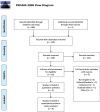The association between fluoroquinolones and aortic dissection and aortic aneurysms: a systematic review and meta-analysis - PubMed (original) (raw)
Meta-Analysis
The association between fluoroquinolones and aortic dissection and aortic aneurysms: a systematic review and meta-analysis
Ian Wee et al. Sci Rep. 2021.
Abstract
Previous studies have drawn causal associations between fluoroquinolone use and collagen pathologies including tendon rupture and retinopathy. This meta-analysisattempted to assess the association between fluoroquinolone use and the risk of aortic dissection or aortic aneurysm. A systematic search was performed on Medline, EMBASE, and the Cochrane library. 9 studies were included in final analysis. Primary random-effects meta-analysis of 7 studies, excluding 2 pharmacovigilance studies demonstrated statistically increased odds of aortic dissection (OR, 2.38; 95% CI, 1.71-3.32) aortic aneurysm (OR, 1.98; 95% CI, 1.59-2.48), and aortic aneurysm or dissection (OR, 1.47; 95% CI, 1.13-1.89; I2 = 72%) with current use of fluoroquinolones compared to their nonuser counterparts. Based on the "number needed-to-harm" analysis, 7246 (95% CI: 4329 to 14,085) patients would need to be treated with fluoroquinolones for a duration of at least three days in order for one additional patient to be harmed, assuming a population baseline incidence of aortic dissection and aneurysm rupture to be 10 per 100,000 patient-years. With strong statistical association, these findings suggest a causal relationship, warranting future research to elucidate the pathophysiological and mechanistic plausibility of this association. These findings however, should not cease prescription of fluoroquinolones, especially when clinically indicated.
Conflict of interest statement
The authors declare no competing interests.
Figures
Figure 1
PRISMA flow diagram.
Figure 2
Association between fluoroquinolone use and aortic dissection.
Figure 3
Association between fluoroquinolone use and aortic aneurysm.
Figure 4
Association between fluoroquinolone use and aortic dissection or aortic aneurysm.
Similar articles
- Risk of aortic aneurysm and aortic dissection with the use of fluoroquinolones in Korea: a nested case-control study.
Son N, Choi E, Chung SY, Han SY, Kim B. Son N, et al. BMC Cardiovasc Disord. 2022 Feb 13;22(1):44. doi: 10.1186/s12872-022-02488-x. BMC Cardiovasc Disord. 2022. PMID: 35152888 Free PMC article. - Fluoroquinolones and the Risk of Aortic Aneurysm or Aortic Dissection: A Systematic Review and Meta-Analysis.
Rawla P, El Helou ML, Vellipuram AR. Rawla P, et al. Cardiovasc Hematol Agents Med Chem. 2019;17(1):3-10. doi: 10.2174/1871525717666190402121958. Cardiovasc Hematol Agents Med Chem. 2019. PMID: 30947680 Free PMC article. - Risk of Aortic Dissection and Aortic Aneurysm in Patients Taking Oral Fluoroquinolone.
Lee CC, Lee MT, Chen YS, Lee SH, Chen YS, Chen SC, Chang SC. Lee CC, et al. JAMA Intern Med. 2015 Nov;175(11):1839-47. doi: 10.1001/jamainternmed.2015.5389. JAMA Intern Med. 2015. PMID: 26436523 - What Fluoroquinolones Have the Highest Risk of Aortic Aneurysm? A Case/Non-case Study in VigiBase®.
Sommet A, Bénévent J, Rousseau V, Chebane L, Douros A, Montastruc JL, Montastruc F. Sommet A, et al. J Gen Intern Med. 2019 Apr;34(4):502-503. doi: 10.1007/s11606-018-4774-2. J Gen Intern Med. 2019. PMID: 30565153 Free PMC article. No abstract available. - Fluoroquinolones and the risk of aortic aneurysm or aortic dissection: an updated systematic review and meta-analysis including 53,651,283 patients.
Fatima K, Uzair SU, Salman A, Jawed A, Husain MA, Shah MG, Hasnain MA, Jawed A, Vohra LI, Lal PM. Fatima K, et al. Minerva Cardiol Angiol. 2023 Oct;71(5):485-493. doi: 10.23736/S2724-5683.22.06124-5. Epub 2022 Dec 5. Minerva Cardiol Angiol. 2023. PMID: 36468763
Cited by
- Analyses of Adverse Drug Reactions to Fluoroquinolones in Spontaneous Reports Before and After the Referral and in Clinical Routine Cases.
Dubrall D, Wicherski J, Below M, Görtzen-Patin J, Schmid M, Zenker S, Haenisch B, Sachs B. Dubrall D, et al. Drugs R D. 2025 Mar;25(1):35-55. doi: 10.1007/s40268-024-00499-x. Epub 2025 Jan 21. Drugs R D. 2025. PMID: 39833604 Free PMC article. - Safety of fluoroquinolones.
Barberán J, de la Cuerda A, Tejeda González MI, López Aparicio A, Monfort Vinuesa C, Ramos Sánchez A, Barberán LC. Barberán J, et al. Rev Esp Quimioter. 2024 Apr;37(2):127-133. doi: 10.37201/req/143.2023. Epub 2023 Dec 22. Rev Esp Quimioter. 2024. PMID: 38140798 Free PMC article. Review. - UK consensus definitions for necrotising otitis externa: a Delphi study.
Hodgson SH, Khan MM, Patrick-Smith M, Martinez-Devesa P, Stapleton E, Williams OM, Pretorius P, McNally M, Andersson MI; UK NOE Collaborative. Hodgson SH, et al. BMJ Open. 2023 Feb 20;13(2):e061349. doi: 10.1136/bmjopen-2022-061349. BMJ Open. 2023. PMID: 36806133 Free PMC article. Review. - Levofloxacin-associated transient mixed sensorimotor lacunar syndrome.
Michelassi F, Bloom J, Su MK, Naqvi IA. Michelassi F, et al. BMJ Case Rep. 2022 Dec 22;15(12):e252052. doi: 10.1136/bcr-2022-252052. BMJ Case Rep. 2022. PMID: 36549757 Free PMC article. - Effect of FluoRoquinolones on Aortic Growth, aortic stIffness and wave refLEctionS (FRAGILES study).
Gardikioti V, Georgakopoulos C, Solomou E, Lazarou E, Fasoulakis K, Terentes-Printzios D, Tsioufis K, Iliopoulos D, Vlachopoulos C. Gardikioti V, et al. Life (Basel). 2024 Aug 9;14(8):992. doi: 10.3390/life14080992. Life (Basel). 2024. PMID: 39202735 Free PMC article.
References
Publication types
MeSH terms
Substances
LinkOut - more resources
Full Text Sources
Other Literature Sources
Medical



